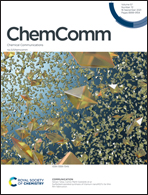Unmasking the reverse reactivity of cyclic N-sulfonyl ketimines: multifaceted applications in organic synthesis
Abstract
The chemistry related to the exploration of cyclic N-sulfonyl ketimines and their derivatives has attracted significant attention in the last few decades because of their intriguing structures and properties. They serve broadly as reactive synthons in various reactions to create a diverse set of synthetically and biologically attractive molecules. Furthermore, these moieties, which possess multiple heteroatoms (N, O and S), display or can enhance many biological activities. In the case of synthetic reactions, chemists mainly focus on the chemical manipulation of the highly reactive prochiral C![[double bond, length as m-dash]](https://www.rsc.org/images/entities/char_e001.gif) N bond of N-sulfonyl ketimines. Besides their traditional role as electrophiles, N-sulfonyl ketimines possess α-Csp3–H protons, and thus behave as potential carbonucleophiles, where they can undergo several C–X (X = C, N and O) bond-forming reactions with different types of electrophiles under various conditions to form a wide range of fascinating asymmetric and non-asymmetric versions of fused heterocycles, carbocycles, spiro-fused skeletons, pyridines, pyrroles, etc. Herein, we highlight the recent examples from our research work and others covering the scope of cyclic N-sulfonyl ketimines as useful carbonucleophiles. In addition, the detailed mechanistic studies of the above-mentioned reactions are also presented.
N bond of N-sulfonyl ketimines. Besides their traditional role as electrophiles, N-sulfonyl ketimines possess α-Csp3–H protons, and thus behave as potential carbonucleophiles, where they can undergo several C–X (X = C, N and O) bond-forming reactions with different types of electrophiles under various conditions to form a wide range of fascinating asymmetric and non-asymmetric versions of fused heterocycles, carbocycles, spiro-fused skeletons, pyridines, pyrroles, etc. Herein, we highlight the recent examples from our research work and others covering the scope of cyclic N-sulfonyl ketimines as useful carbonucleophiles. In addition, the detailed mechanistic studies of the above-mentioned reactions are also presented.



 Please wait while we load your content...
Please wait while we load your content...